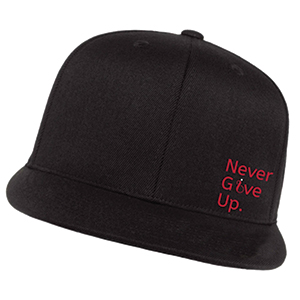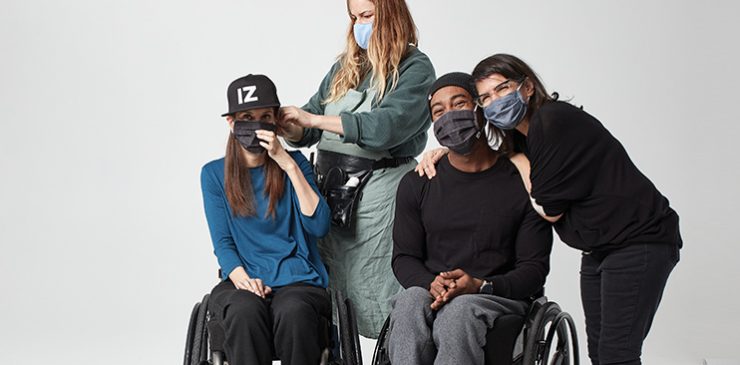Our clothes say a lot about us. How we dress reflects our individuality, creativity and most of all our self-image and dignity. For many of us with disabilities, it is so much more. Our clothes need to be functional, affordable and attractive. They need to reflect who we are while supporting our physical needs.
When you have a disability, many of your choices are taken away from you. Choosing what you wear and feeling good in it, should not be one of them.
Many clothing stores and dressing rooms are not designed with mobility in mind. This is an issue of accessibility that is reflected in many public spaces. The added layer with clothing is if you can get into the store and make it through the racks, you are quite often faced with the choice of adaptive clothing designed with only easy dressing in mind or clothes that may better reflect your personal style but with features that make them difficult to wear or sometimes harmful to your physical well-being.
When you are living with a disability the functionality of your clothes is critical. Clothes need to be easy to put on and remove and conceal or provide access to materials/devices associated with personal care. Affordability is an added challenge for people on a disability pension or with limited income. Dressing for comfort, wellness, dignity and style should be available to all. I spoke with three individuals who truly believe this and are doing what they can to make it happen.

“Whether you have multiple sclerosis, a spinal cord injury, or cerebral palsy, your body is seated all day. The clothes need to fit and not cause discomfort, or injury.”
– Izzy Camilleri | izadaptive.com
Izzy Camilleri began her career in fashion in the mid ’80s. She has designed high-end collections and provided custom wardrobes for film sets. One of her designs, a coat, was worn by Meryl Streep in the movie, “The Devil Wears Prada,” a film about the highest echelons of the fashion world. Her introduction to meeting the needs of people with disabilities came in 2005 when she met journalist and disability activist Barbara Turnbull. The Fashion Editor at the Toronto Star referred Barbara to Izzy because Barbara wanted clothing that was fashionable and adapted to her needs.
For Izzy, it was an instant revelation for her into the world of disability. She realized that there were few stylish options for Barbara and that there must be more people with disabilities with the same needs and frustrations. Since Barbara used a wheelchair, Izzy recreated the patterns for a seated frame so that the clothing fits smoothly and effortlessly. Most clothes are designed with the perspective of the wearer standing.

Following the clothing Izzy created for Barbara, she collaborated with another woman who used a wheelchair. She requested a coat without a bottom for easier wear. For the woman, who received many compliments on the coat, she gained self-confidence. For Izzy, she realized she had done more than designed a coat – she made a difference to someone.
There are many considerations in designing adaptive clothing, according to Izzy, who advises: “Do your research and familiarize yourself with the diverse needs of people with disabilities.” When she started out in adaptive fashion, she spoke to people with disabilities to identify their common needs.
“Whether you have multiple sclerosis, a spinal cord injury, or cerebral palsy, your body is seated all day. The clothes need to fit and not cause discomfort, or injury.” Bulky seams can cause pressure sores; sitting waistlines need to be comfortable as organs can settle from being seated. Reduced dexterity in the hands requires larger buttons. Closures on zippers need to be rethought.
Izzy considered Universal Design and her clothing line contain many features that make dressing easier and clothing more comfortable. Some of the adaptive features in her designs include coats with magnets for easier access; long winter coats that stop at the waist in the back so that the coat can be put on while seated. Men’s pants have zippers that go down further and coming soon, women’s pants where the front flap goes down further to accommodate an ostomy.
Izzy has seen much progress in the world of adaptive fashion over time. For example, for residents of long-term care, neither style nor comfort were prioritized. Clothing was made of sturdy synthetics that could withstand high laundry temperatures. However, synthetic material is not breathable and may cause pressure sores. The prime focus seemed to be on making the clothing more convenient for the staff who dressed the patients. Ease of dressing and durability were prioritized.
Now, however, more people are starting to understand the needs of the disability community and trying to provide the function with style like Izzy with her IZ Adaptive line. While some designers such as Tommy Hilfiger have embraced adaptive fashion, Izzy would like to see more fashion designers explore this niche. Izzy has this advice for someone with an interest in becoming an adaptive fashion designer: do your research.
Benjamin (Ben) Kwarteng lives his research. Ben has a high-level spinal cord injury following a car crash in 2008. As a young man, prior to his accident, Ben loved to pick out clothes to express himself. He had to wear a uniform in school, like everyone else, however, one day each month was dress-down day. Ben saved his lunch money so he could buy clothes to show off his style.

“People need options and fashion designers need to be open and willing to include the needs of people with disabilities in their clothing designs. Affordability is another consideration, for people who are on a limited income or a disability pension. Many of us are just trying to survive and meet our basic needs.”
– Ben King
Following his injury, a photograph was taken of him in the hospital. He was shocked by what he saw. He looked depressed and not at all stylish and confident. He did not look or feel like himself; wearing clothes that were easy for the staff to put on and take off and for him to move around in his wheelchair. He was not impressed with the available options for people with disabilities. He said most clothing lines assume you get bigger and baggier clothes to make it easier for you or your attendants to help you get dressed. This did not feel right for him. Dressing this way increased his depression and did not help him in his recovery at all. It was not who he was.
So, he took charge and gradually made changes in his appearance. He started doing some online shopping in search of fashionable and comfortable clothing. His love of fashion and desire to give people with disability options has led him to develop an adaptive clothing line. While the pandemic has delayed the production of his line he’s excited at the options he’s bringing to the community.
In designing clothes, Ben considers comfort and style. “Regular buttons are difficult for someone with limited use of their hands.” He uses magnetic buttons that snap or Velcro straps. Zippers in pants, if placed strategically, can conceal a catheter or leg bag.
“People need options and fashion designers need to be open and willing to include the needs of people with disabilities in their clothing designs. Affordability is another consideration for people who are on a limited income or a disability pension. Many of us are just trying to survive and meet our basic needs.”
For Ben, well-made, adaptive and attractive clothing provides a sense of identity and comfort. “I feel like a new person in my new clothes when there is a choice in the colours, fabrics and style. I’m like a kid in a candy store. I have a sense of independence. Often disability takes away one’s sense of independence.” Most impactfully, fashion reflects Ben’s confidence and moves his disability from the forefront of his public image. “Often, disability is the first thing people see. When I am well dressed and confident people do not see my chair, but this well-dressed guy who is well put together. Fashion should be the first thing people see. Not the last.” He says, “When I’m out in public some of the comments that I often receive are ‘wow you look fresh and very well put together for a person in a wheelchair.’ I always ask myself, what does a person in a wheelchair supposed to look like?”
Travis Iverson sustained a spinal cord injury in 2003 while diving into a shallow lake. Like Ben, he not only has an interest in adaptive fashion, but also likes to dress fashionably himself and knows the impact that well-designed, comfortable and adaptive clothing can have on a person’s mental and physical health.

In 2013 Travis developed concepts for his adaptive clothing line, Iver Fashion, which has shorts and pants without pockets or seams. The clothes are roomy with skin-friendly materials to foster skin integrity and lessen the likelihood of skin breakdown. The seat in the material in the pants has moisture-wicking and contains silver cell, an ingredient used in wound care and charcoal, which is odour resistant. The clothing line also has unique adaptive features for easier removal and independence.
Travis is currently undertaking an online initiative selling “Never Give Up” hats and other items in a fundraising collection so that he can bring his remaining accessibility garments and accessories to market. Pre-orders can be made for his staple pieces which consist of: A-frame dress shirts; armpit ventilation golf shirts; casual shorts and pants.
You can learn more about Travis and his initiatives at his website www.iverfashion.com
People with disabilities are consumers and need to be considered in fashion design. We cannot remain silent and accept the status quo. If we start making our own changes, the fashion world will surely catch up. It takes time for these changes in design to evolve. But the results are worth it. There needs to be options – not just “whatever fits.” We are getting there, thanks to dedicated, skilled and passionate people like Izzy, Ben and Travis.






